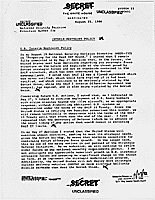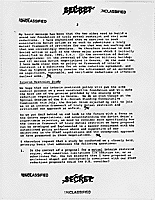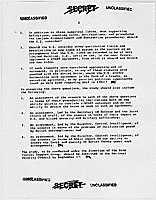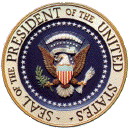
1 (larger access file - 116021 bytes) | 
2 (larger access file - 118700 bytes) |

3 (larger access file - 112423 bytes) |
 [National
Security Decision Directives]
[National
Security Decision Directives]
Interim Restraint Policy
(NSC-NSDD-236)
8/22/86 18:53:21
SECRET
ADMIRAL, ATTACHED BELOW IS THE TEXT OF A PACKAGE ON INTERIM RESTRAINT THAT WE
DISCUSSED EARLIER THIS WEEK. THE PACKAGE WENT INTO OUR SYSTEM ON FRIDAY AT
COB BUT IT LIKELY WILL NOT MAKE IT TO YOU UNTIL MONDAY AT THE EARLIEST, SVEN
WILL PRESS ON WITH THE MEETINGS THAT ARE REFERENCED IN THE COVER MEMO TO YOU
WHICH IS NEXT BELOW. ANY FEEDBACK THAT WE ARE ON THE WRONG PATH IS NEEDED
SOONEST. PROMPT ACTION ON THE PACKAGE WHEN IT ARRIVES WOULD BE HELPFUL. I
WILL BE IN GENEVA UNTIL WEDNESDAY (RISK REDUCING), SO IF ADDITIONAL GUIDANCE,
PLEASE PASS DIRECTLY TO SVEN.
BEGIN TEXT OF COVER NOTE TO YOU
SECRET
MEMORANDUM FOR JOHN M. POINDEXTER
FROM: SVEN KRAEMER/BOB LINHARD
SUBJECT: Interim Restraint Policy
As the Administration prepares for a new series of U.S.-Sovlet meetings in
September/October (including NST experts, Shultz -Shevardnadze, NST
resumption, and SCC) and in the face of Congressional legislation seeking to
mandate arms control by legislative fiat, we need to consider more
specifically how future U.S. restraint, and the interim framework of truly
mutual interim restraint we have proposed, can be developed and implemented in
a manner consistent with established policy guidance and supportive of our
objectives and our approach in the START negotiations.
In particular, we need to be clear on what our interim restraint policy is,
and on a close-hold and timely basis, to have a study prepared on possible
interim limitations on strategic arms (including limitations that might be
drawn from SALT and some that might be new) consistent with U.S. policy and
with the START negotiations.
We believe such work would best be tasked through an NSDD and worked through a
special group. Accordingly, we have prepared an NSDD at Tab A for the
President's signature, summarizing established U.S. interim restraint policy
and tasking preparation of a study on the above elements through the Arms
Control Support Group by mid-September. Because the document includes a
statement of policy, and to give it more weight, we have titled it as a NSDD
rather than as an NSSD.
We have touched base informally on the tasking aspects of this NSDD with
appropriate CIA and OSD reps and will do so with other agencies soon. We
propose to have a special subgroup of the Arms Control Support Group Work this
study (probably in a compartmented channel) and will try for a first draft for
Support Group review by Labor Day, with the final product due to the NSC by
September 17. We propose to kick off the effort with a meeting of such a group
next Tuesday, August 25, starting with an inventory and assessment of SALT
limitations, definitions, counting rules, notifications, etc., that to be
considered for carrying forward if consistent with the U.S. proposal on START
and with U.S. policy on interim restraint.
A memorandum explaining the purpose of the NSDD and recommending the
President's signature is attached for your approval at Tab I, A memorandum of
transmittal to agencies is attached at Tab II, for use if and when the
President signs the NSDD.
RECOMMENDATION: That you sign the memorandum to the President at Tab I
forwarding the proposed NSDD for his signature.
BEGIN TAB I -- MEMO TO THE PRESIDENT
MEMORANDUM FOR THE PRESIDENT
FROM: JOHN M. POINDEXTER
SUBJECT: Interim Restraint Policy
Issue: Whether you should sign the attached National Security Decision
Directive (NSDD) summarizing U.S. interim restraint policy and requesting an
interagency study on its further development and implementatlon consistent
with our objectives and our proposal in the START negotiations.
Background: In June, 1985, you decided to go the extra mile with the SALT I
and SALT II agreements in order to give the Soviet Unlon adequate time to join
us in an interim framework of truly mutual restraint by: (1) correcting its
noncompliance; (2) reversing its military buildup; and (3) negotiating
seriously in Geneva. In May 27, 1986 you decided that in view of Soviet
failure during the preceding year to allay our concerns and to make progress
in these three areas, the United States would base future U.S. strategic force
decisions on the magnitude of the threat posed by Soviet forces and not on
standards contained in the SALT structure, which was being undermined by
continued Soviet noncompliance, and which involved two agreements that had
expired and, in the case of SALT II, were unratified. You indicated that
while the Unlted States would remain in technical observance of the terms of
the SALT II Treaty for some months because of the Poseidon submarine
retirements this summer, you intended later this year to continue deployment
of U.S. heavy bombers with cruise missiles beyond the 131st aircraft without
dismantling additional U.S. systems as compensation under the SALT II Treaty.
At the same time, you urged a priority focus on achieving an equitable and
verifiable agreement on significant reductions in U.S. and Soviet nuclear
arms. While pledging utmost U.S. restraint, you invited the Soviet Union to
join us in an interim framework of truly mutual restraint pending achievement
of such an agreement. In addition, as matters of unilateral restraint, you
indicated that, assumlng no significant change in the threat we face, the
United States will not deploy more strategic nuclear delivery vehicles (SNDVs)
or strategic ballistic missile warheads than the Soviet Union.
At the Special Session of the U.S.-Soviet Standing Consultative Commission
(SCC) held in Geneva at the end of July, the Soviets asserted that they were
in full compliance, rejected your call for an interim framework of truly
mutual restraint, and characterized as unfair your position on SNDVs and
strategic ballistic missile warheads. Meanwhile, the Congress, in particular
the House, is seeking to impose SALT I limits on the United states through
legislative fiat.
Discussion: In light of the above considerations and as we approach major
U.S.-Soviet meetings this fall, we need to consider more specifcally how
future U.S. restraint, and the interim framework of truly mutual restraint we
have proposed, can be developed and implemented in a manner consistent with
established policy guidance and supportive of our objectives and our approach
in the START negotiations.
Accordingly, as we seek Soviet correction of their noncompliance and a
reversal of their strategic arms buildup, we also belleve it helpful to have a
study prepared on possible interim limitations on strategic arms, including
limitations that might be drawn from SALT and some that might be new,
consistent with U.S. policy and with the START negotiations. The NSDD
attached for your signature at Tab A summarizes established U.S. interim
restraint policy and requests preparation of such a study through the Arms
Control Support Group by mid-September.
Recommendation: That you sign Nationai Security Decision Directive at Tab A.
BEGIN TEXT OF DRAFT NSDD -- TAB A
INTERIM RESTRAINT POLICY (U)
U.S. Interim Restraint Policy. In my August 19 National Security Decision
Directive (NSDD-232) on "Preparing for the Next NST Round," I stated that I
remain fully committed to my May 27 decision that, in the future, the United
States must base decisions regarding its strategic force structure on the
nature and magnitude of the threat posed by Soviet strategic forces and not on
standards contained in the SALT structure, which has been undermined by Soviet
noncompliance. I noted that SALT II was a flawed agreement which was never
ratified which would have expired if it had been ratified and which continues
to be seriously violated by the Soviet Union, while the SALT Interim Offensive
Agreement was unequal, has expired, and is also being violated by the Soviet
Union. (S)
Concerning future U.S. actions, I noted that, as I indicated on May 27, I
intend to continue deployment of U.S. heavy bombers with cruise missiles
beyond the 131st Aircraft, as an appropriate response, without dismantling
additional U.S. systems as compensation under the terms of the SALT II Treaty.
Since the United States is retiring two Poseidon submarines this summer, we
will remain technically in observance with the terms of the SALT II Treaty
until that event near the end of the year, I have requested that the Secretary
of Defense inform me in advance of the exact timing of any action that would
result in exceeding SALT II limits. (S)
In my May 27 decision I stated that the United States will exercise utmost
restraint, seeking to meet its strategic needs, given the Soviet buildup, by
means that minimize incentives for continuing Soviet offensive force growth.
In the longer term, this is one of the major motives in our pursuit of the
Strategic Defense Initiative. As we modernize, we will continue to retire
older forces as our national security requirements permit. I do not
anticipate any appreciable numerical growth in U.S. strategic offensive forces
and assuming no significant change in the threat we face, as we implement the
strategic modernizatlon program. Additionally, the United States will not
deploy more strategic nuclear delivery vehicles (SNDVs) or more strategic
ballistic missile warheads than does the Soviet Union, (S)
My basic message has been that the two sides need to build a sound new
foundation of truly mutual restraint and real arms reductions. I have
emphasized that we continue to seek constructive Soviet action as we work to
substitute a truly mutual framework of restraint for one that was not working
and that was increasingly obsolete. We therefore continue to seek Soviet
action in each of the three major areas which I initially identified in June,
1985, i.e.: (1) the correction of Soviet noncompliance; (2) the reversal of
the Soviet military buildup, and (3) serious Soviet negotiations in Geneva.
At the same time, I have made clear that no policy or framework of interim
restraint is a substitute for an arms reduction agreement, and that my hlghest
priority remains the achievement of an agreement on significant, equitable,
and verifiable reductions in offensive nuclear arms. (S)
Interim Restraint Study. We hope that our interim restraint policy will put
the arms control process on a more constructive foundation and will make the
best use of the promise provided by the ongoing arms reduction negotiations in
Geneva. We do so even though at the Special Session of the U.S.-Soviet
Standing Consultative Commission this July, the Soviet Union rejected my call
to join us in an interim framework of truly mutual restraint and criticized
our approach as unfair. (S)
As we put SALT behind us and look to the future with a focus on the Geneva
negotiations, and notwithstanding the Soviet Union's regrettable rejection, we
need to consider more specifically how the interim framework of truly mutual
restraint we have proposed can be developed and implemented in a manner
consistent with the established policy guidance above and supportive of our
objectives in the START negotiations and the conceptual approach we have
presented in those negotiations. (S)
I therefore request that a study be conducted on a closely held, priority
basis that addresses the following questions:
1. In the context of a proposal for a mutual interim restraint regime, what
numerical limitations (in addition to, or as substitutes for, the two measures
that I have proposed as unilateral steps) and conceptually consistent with our
START reductions proposals could the U.S. consider?
2. In addition to these numerical limits, what supporting
definitions, counting rules, notifications, and procedures (to include
dismantlement and destruction procedures) should the U.S. consider?
3. Should the U.S. consider other qualitative limits and
restrictions on new types of system in the context of an arrangement that the
U.S. views as intended to be of very limited duration, i.e., until we can, in
the near future, implement a START agreement, from which it should not divert
the two sides.
4. If such elements were considered appropriate and if agreement, in
principle, on any of these elements were reached with the Soviet Union, would
the U.S. prefer documentlng such agreement in the form of a treaty, an
executive agreement, or by parallel political commitments (such as were made
regarding SALT in 1982)? (S)
In answering the above questions, the study should also include the following:
1. An assessment of the answers to each of the above questions in terms of
their precedential implications both on our ability quickly to conclude a
START agreement and on our ability to obtain the terms we seek in such an
agreement;
2. An assessment, led by the Secretary of Defense and the Joint Chiefs of
Staff, of the answers in terms of their impact on U.S. and Allied security and
military sufficiency;
3. An assessment, led by the Director, Central Intelligence, of the answers
in terms of the problems of verification posed by Soviet noncompliance; and
4. An assessment, led by the Director, Central Intelligence, of the answers
in terms of their impact on our ability to assess the level and quality of
Soviet forces under such arrangements. (S)
The study, to be conducted under the direction of the Arms Control Support
Group should be submitted to the National Security Council by September 17.
(C)
BEGIN DISTRIBUTION MEMO FOR AGENCIES
MEMORANDUM FOR THE VICE PRESIDENT THE SECRETARY OF STATE, THE
SECRETARY OF DEFENSE, THE DIRECTOR OF CENTRAL
INTELLIGENCE THE CHAIRMAN JOINT CHIEFS OF STAFF, THE DIRECTOR, ARMS CONTROL
AND DISARMAMENT AGENCY
SUBJECT: NSDD- on U.S. Interim Restraint Policy (S)
The President has approved the attached National Security Decision Directive
providing guidance on U.S. Interim Restraint Policy and requesting a study on
how future U.S. restraint, and the interim framework of truly mutual restraint
have proposed, can be developed and implemented in a manner consistent with
the established policy guidance and supportive of our objectives and our
approach in the START negotiations. (S)
Due to the sensitivity of this subject, this NSDD should be restricted to
those who must have access in support of the requested study.(C)
SECRET
Declassify on: OADR
END TEXT OF PACKAGE

1 (larger access file - 116021 bytes) | 
2 (larger access file - 118700 bytes) |

3 (larger access file - 112423 bytes) |
Ronald Reagan Library (NLS), 40 Presidential Drive, Simi Valley, CA 93065-0666 PHONE: 805-522-8444 FAX: 805-522-9621